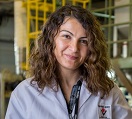
Parvana Aksoy
TUBITAK MRC Energy Institute
Turkey
Title: Production of biocrude oil by waste biomass CatLiq process and characterization of oils
Biography
Biography: Parvana Aksoy
Abstract
The CatLiq process is a thermochemical conversion of wet biomass with process conditions at the critical point of water. This technology has similarities to other thermochemical conversion processes such as liquefaction, pyrolysis and gasiï¬cation. But it cannot be classiï¬ed exactly as one of these technologies. This process is a continuous process that takes place at supercritical point of water by using both heterogeneous and homogeneous catalysts. Seven different waste biomass samples, such as saw dust, black liqour, paper mill sludge, bark, cow manure, sewage and bio gasification sludge were subjected to Catliq process. Biocrudes, gases and aqueous samples obtained from these processes were subjected to characterization tests. Biocrudes obtained from different waste biomass by Catliq process were dark brown, free-flowing liquids and had distinctive odor. The densities of biocrude oils were ~1.10 g/m3, higher than the density of petroleum crude oils. Crude bio-oils was a complex mixture of several hundreds of organic compounds, mainly including acids, alcohols, aldehydes, esters, ketones, phenols, and lignin-derived oligomers. Some of these compounds are directly related to the undesirable properties of bio-oil. Raw bio-oils obtained from liquefaction of different kinds of waste biomass had very high water content, high viscosity and density and high oxygen content. The heating values of raw bio-oils were between 32.0-37.06 MJ/kg, lower than crude oil. Biocrude obtained from catalytic liquefaction of sewage sludge had highest heat of combustion (37.06MJ/kg). It is obvious that waste biomass can be utilized to produce crude bio-oil and CatLiq process is a promising alternative technological pathway for the production of crude bio-oil. Crude bio-oils obtained from CatLiq process can be used as a combustion fuel in boiler/burner/furnace systems for heat generation, as a transportation fuel after upgrading, for the production of chemicals and resins (e.g., agri-chemicals, fertilizers, acids and emission control agents), also as a feedstock in making adhesives, e.g., asphalt bio-binders. Depending to feedstock some crude bio-oils can be mixed with crude petroleum oil up to 3% and can be refined together using petroleum refinery systems.
